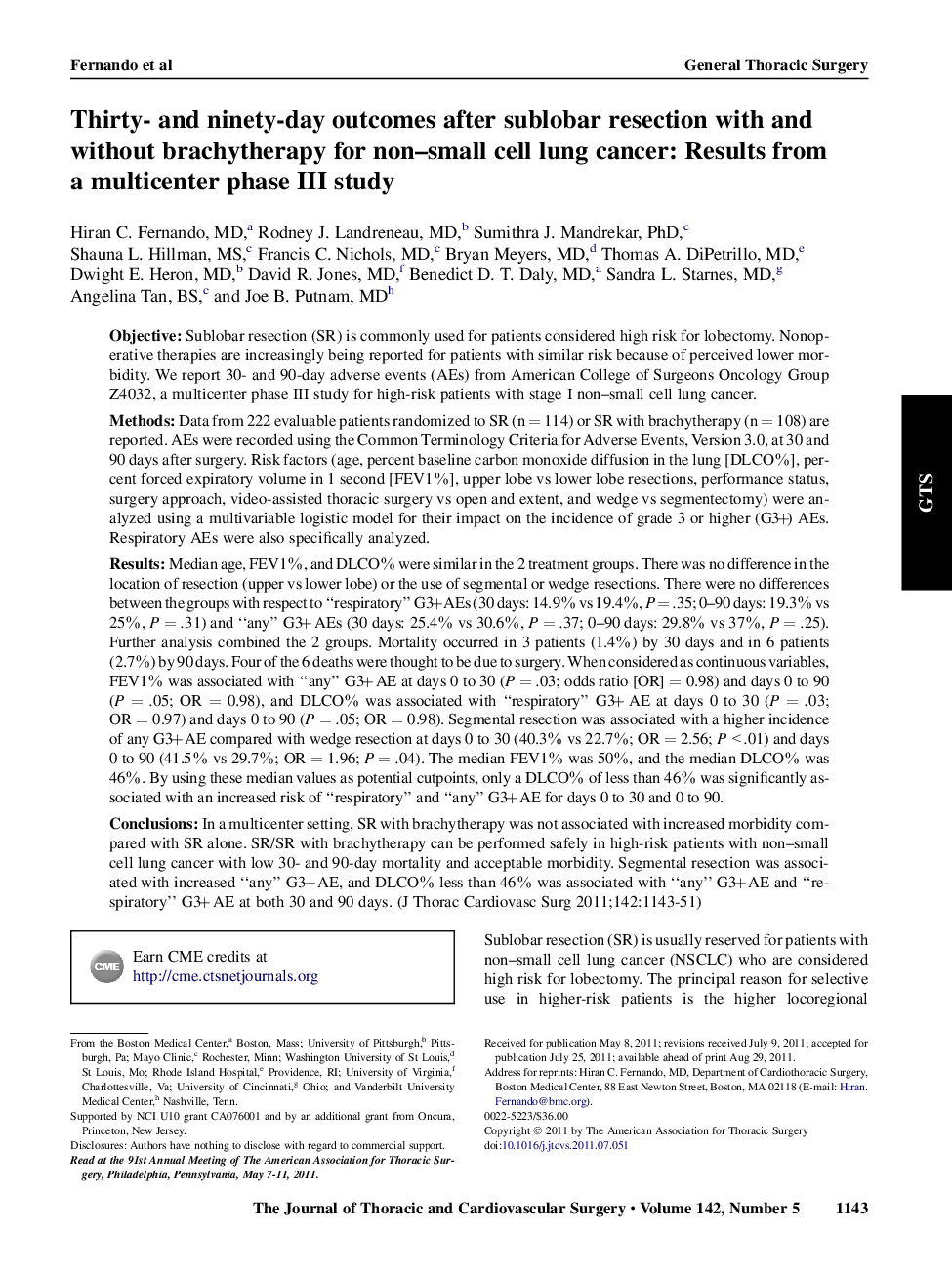| کد مقاله | کد نشریه | سال انتشار | مقاله انگلیسی | نسخه تمام متن |
|---|---|---|---|---|
| 5990682 | 1578643 | 2011 | 9 صفحه PDF | دانلود رایگان |

ObjectiveSublobar resection (SR) is commonly used for patients considered high risk for lobectomy. Nonoperative therapies are increasingly being reported for patients with similar risk because of perceived lower morbidity. We report 30- and 90-day adverse events (AEs) from American College of Surgeons Oncology Group Z4032, a multicenter phase III study for high-risk patients with stage I non-small cell lung cancer.MethodsData from 222 evaluable patients randomized to SR (n = 114) or SR with brachytherapy (n = 108) are reported. AEs were recorded using the Common Terminology Criteria for Adverse Events, Version 3.0, at 30 and 90 days after surgery. Risk factors (age, percent baseline carbon monoxide diffusion in the lung [DLCO%], percent forced expiratory volume in 1 second [FEV1%], upper lobe vs lower lobe resections, performance status, surgery approach, video-assisted thoracic surgery vs open and extent, and wedge vs segmentectomy) were analyzed using a multivariable logistic model for their impact on the incidence of grade 3 or higher (G3+) AEs. Respiratory AEs were also specifically analyzed.ResultsMedian age, FEV1%, and DLCO% were similar in the 2 treatment groups. There was no difference in the location of resection (upper vs lower lobe) or the use of segmental or wedge resections. There were no differences between the groups with respect to “respiratory” G3+ AEs (30 days: 14.9% vs 19.4%, P = .35; 0-90 days: 19.3% vs 25%, P = .31) and “any” G3+ AEs (30 days: 25.4% vs 30.6%, P = .37; 0-90 days: 29.8% vs 37%, P = .25). Further analysis combined the 2 groups. Mortality occurred in 3 patients (1.4%) by 30 days and in 6 patients (2.7%) by 90 days. Four of the 6 deaths were thought to be due to surgery. When considered as continuous variables, FEV1% was associated with “any” G3+ AE at days 0 to 30 (P = .03; odds ratio [OR] = 0.98) and days 0 to 90 (P = .05; OR = 0.98), and DLCO% was associated with “respiratory” G3+ AE at days 0 to 30 (P = .03; OR = 0.97) and days 0 to 90 (P = .05; OR = 0.98). Segmental resection was associated with a higher incidence of any G3+ AE compared with wedge resection at days 0 to 30 (40.3% vs 22.7%; OR = 2.56; P < .01) and days 0 to 90 (41.5% vs 29.7%; OR = 1.96; P = .04). The median FEV1% was 50%, and the median DLCO% was 46%. By using these median values as potential cutpoints, only a DLCO% of less than 46% was significantly associated with an increased risk of “respiratory” and “any” G3+ AE for days 0 to 30 and 0 to 90.ConclusionsIn a multicenter setting, SR with brachytherapy was not associated with increased morbidity compared with SR alone. SR/SR with brachytherapy can be performed safely in high-risk patients with non-small cell lung cancer with low 30- and 90-day mortality and acceptable morbidity. Segmental resection was associated with increased “any” G3+ AE, and DLCO% less than 46% was associated with “any” G3+ AE and “respiratory” G3+ AE at both 30 and 90 days.
Journal: The Journal of Thoracic and Cardiovascular Surgery - Volume 142, Issue 5, November 2011, Pages 1143-1151